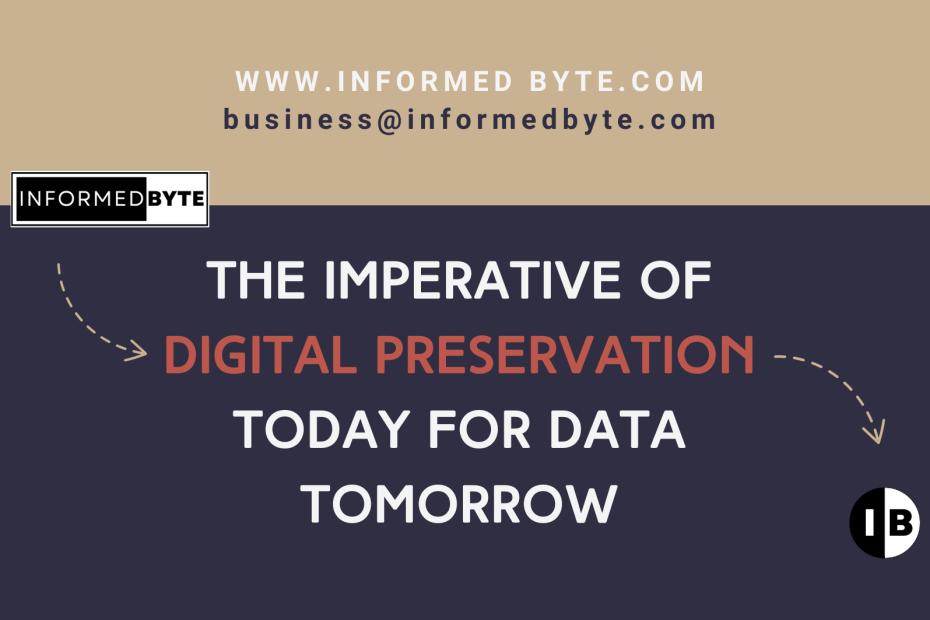The imperative of digital preservation today for data tomorrow
September 14, 2023
In our increasingly digitalised world, information is generated, disseminated, and consumed at an unprecedented rate. From personal photographs to scholarly research, the majority of our valuable content now exists in digital form. However, this digital transformation has introduced new challenges, particularly regarding the preservation of digital assets. In this era of rapid technological advancements, ensuring that our digital heritage endures for future generations requires meticulous planning, investment, and expertise in the field of digital preservation.

Image credit by Claudio Schwarz on Unsplash
Digital preservation refers to the set of activities and strategies aimed at safeguarding digital materials against the threats of obsolescence, degradation, and loss. As the custodians of vast amounts of digital information, individuals, businesses, organisations, and institutions have a moral and practical responsibility to preserve this digital legacy. In the information age, digital preservation is essential for the survival of not only our businesses but also cultural, scientific, and intellectual heritage.
Threats to Digital Preservation
1. Technological Obsolescence
One of the most pressing threats to digital preservation is technological obsolescence. Digital formats, software, and hardware have a limited lifespan, and as they become obsolete, the content stored within them becomes inaccessible. Dr. Clifford Lynch, the Executive Director of the Coalition for Networked Information, warns that without active management, digital objects will degrade and become obsolete. In the short-term this means unusable assets, longer term it renders them lost to future generations.
2. Data Degradation
Data degradation is another critical concern. Over time, digital files may suffer from bit rot, file corruption, or data loss. Dr. William Kilbride, Executive Director of the Digital Preservation Coalition, notes, “Digital data is fragile and vulnerable to degradation. Without proper care, data can become unreadable or unusable”.
3. Rapid Technological Advancements
The pace of technological change is relentless, resulting in frequent updates and migrations. As technology advances, content stored in older formats becomes harder, very costly and eventually impossible to access. Migration and emulation are strategies to combat this challenge.
Strategies for Digital Preservation
1. Format Migration
To combat format obsolescence, experts recommend a proactive strategy of format migration. This process involves periodically converting digital content to contemporary formats, ensuring continued accessibility, ensuring extend life of digital materials hence mitigating the risks of obsolescence.
2. Metadata and Documentation
Robust metadata and documentation are vital for digital preservation. Metadata is vitally important, it provides context and ensures the discoverability of digital assets, making it a cornerstone of digital preservation efforts.
3. Emulation
Emulation involves simulating older hardware and software environments to access digital content. Dr. David Rosenthal, a renowned digital preservation expert, underscores the importance of emulation, stating, “Emulation allows us to recreate the original computing environment, ensuring the continued accessibility of digital objects”.
Legal and Ethical Considerations
1. Copyright and Intellectual Property
Navigating the legal landscape is a significant challenge in digital preservation. Preserving of digital materials while respecting copyright law requires time to understand fair use and licensing agreements.
2. Privacy and Data Protection
Preserving digital assets often involves personal and sensitive data. Dr. Michelle Gallinger, Director of Digital Preservation Services at Stanford University Libraries, highlights the ethical dimension, saying, “Balancing the preservation of cultural heritage with privacy and data protection concerns is a complex ethical challenge.”
Funding and Sustainability
1. The Cost of Preservation
Digital preservation is not without its costs. Sustainable funding models are crucial for the long-term preservation of digital materials, ensuring that resources are available for ongoing maintenance and migration. Partnership projects, philanthropy or grants within the digital initiatives field should be considered by businesses for data preservation.
2. The Role of Governments
Governments play a pivotal role in digital preservation efforts. Government support and policies can greatly facilitate digital preservation by providing business support, resources and establishing legal frameworks.
What now?
Contact Informed Byte for a free discussion, and collaboration to consider the current situation, establish business information goals and identify possible solutions.
Contact us for more information about digital preservation
